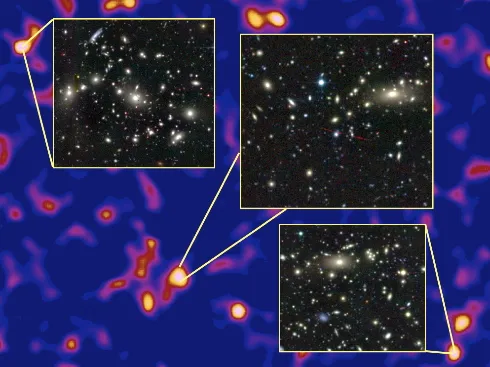
The main image here reveals the distribution of dark matter, with light areas containing a higher concentration of dark matter. As the insets show, regions that contain a lot of dark matter are typically also rich in clusters of galaxies.
Credit: Van Waerbeke/Hymans/CFHTLens
At a meeting of the American Astronomical Society in Austin, Texas yesterday (9 January), a team led by Dr Catherine Heymans of the University of Edinburgh and Prof Ludovic Van Waerbeka of the University of British Columbia presented the findings of a survey that has mapped the distribution of dark matter in the Universe more thoroughly than has ever previously been achieved.
The study, known as the Canada-France-Hawaii Telescope Lensing Survey (CFHTLens), analysed images of around 10 million galaxies in four different regions of the sky. It studied the distortion of light emitted by these galaxies, which is ‘bent’ by passing through clumps of dark matter during its journey to Earth. The images were obtained as part of the earlier Canada-France-Hawaii Telescope Legacy Survey, and were taken using a 340-megapixel CCD camera with a 1x1-degree field of view. The galaxies studied typically lie around six billion lightyears from Earth.
Prof Van Waerbeke said: “It is fascinating to be able to ‘see’ the dark matter using space-time distortion. It gives us privileged access to this mysterious mass in the Universe which cannot be observed otherwise. Knowing how dark matter is distributed is the first step towards understanding its nature and how it fits within our knowledge of physics.”
Dr Heymans added: “By analysing light from the distant Universe, we can learn about what it has travelled through on its journey to reach us. We hope that by mapping more dark matter than has been studied before, we are a step closer to understanding this material and its relationship with the galaxies in our Universe.”